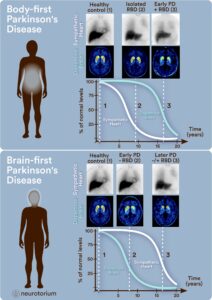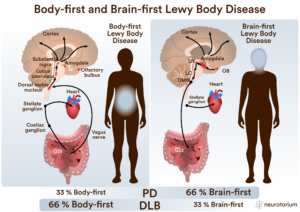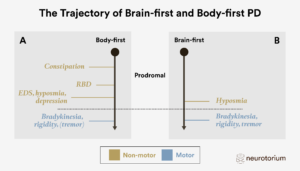Index for
slide deck
Introduction

Epidemiology and burden
Prevalence of Parkinson’s disease

Prevalence of Parkinson’s disease

Parkinson’s disease is a widespread public health issue
Although PD is the fastest growing neurodegenerative disorder worldwide,1,6 it is difficult to estimate the total number of people in the world who are affected by PD, as the methods used to collect these data differ between countries.10 In a study published in 2007, the …

Prevalence of Parkinson’s disease – North and South America
Approximately 1 million individuals in the USA are living with PD.1,2 According to data from the Parkinson’s Foundation Parkinson’s prevalence project (PPPP), 1.2 million people will be living with PD in the USA by 2030.1
Interestingly, there are geographic variations se…

Prevalence of Parkinson’s disease – Europe
As outlined on the slide, by some estimates the prevalence of PD appears to be higher in Europe than the rest of the world.2 The population in Europe is broadly older than that of the whole world, meaning that the European population may be more vulnerable to diseases whe…

Prevalence of Parkinson’s disease – Africa
There appears to be an upward trend in the prevalence of PD in the Middle East and North Africa.1 However, data are scarce; an analysis of the Global Burden of Disease (GBD) surveys 1990–2016 found no data were available for central sub-Saharan Africa, and southern sub-Sa…

Prevalence of Parkinson’s disease – Western Pacific Region and Southeast Asia
As detailed on the slide, the range of different reported prevalence values for PD in the Western Pacific Region and Southeast Asia are lower than those reported in Europe.1,7 Besides variability in methodology between studies, there are other factors that could contribut…

Ethnic variations in Parkinson’s disease
The ethnic variations in PD are thought to be driven by:1
- biological factors (e.g., genetics, vascular disease, dementia-associated pathology, and other comorbidities)
- non-biological factors (e.g., healthcare system inequalities, under-reporting of symptoms).
References…

Prevalence of Parkinson’s disease by age
The prevalence of PD increases with advancing age.1 In a meta-analysis of worldwide prevalence data, PD was found to be >40 times more prevalent in populations aged ≥80 years than in those aged 40–49 years.1 Generally, PD is rare in individuals <40 years old.3
Normally, t…

Prevalence of Parkinson’s disease by sex
Although there is strong evidence to indicate that a person is more likely to develop PD as they become older, the effect of sex is less clear-cut.1
Analysis of worldwide data found generally higher levels of PD in male populations.1,2 However, the differences were only s…

Predictions of the increase in Parkinson’s disease prevalence
Life expectancy continues to grow in the world’s rapidly developing low- and middle-income (LMIC) countries.5 As survival rates improve, due to better economic conditions and healthcare, the prevalence of age-related chronic diseases (including PD) is expected to rise acc…

Risk factors associated with Parkinson’s disease
Approximately 85–95% of PD cases are ‘sporadic’ or ‘idiopathic’, meaning that the cause is unknown.5,6 However, the disease is known to cluster in families, with approximately 5–15% of patients reporting a family history of PD.5,6 There are now several well-established PD…















